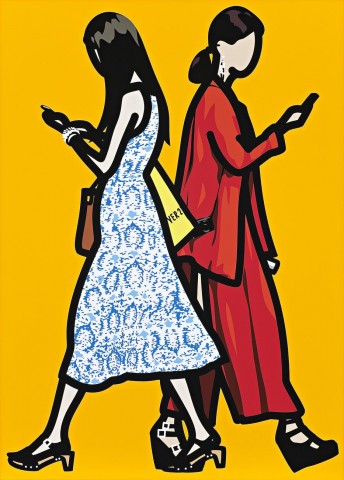PAISLEY DRESS AND RED GOWN, 2015
JULIAN OPIE
silkscreen on painted wooden board
100.5 x 72.5 cm
signed verso: Julian Opie
Gerhardsen Gerner, Berlin
Private collection, Melbourne, acquired from the above in 2015
Gerhardsen Gerner at Art Basel, Hong Kong, 15 – 17 March 2015
Julian Opie (online catalogue raisonné)
https://www.julianopie.com/painting/2015/paisley-dress-and-red-gown (accessed 14/03/19)
With slick surfaces and a distinctive, ultra-legible pictorial style, Julian Opie creates images that are uniquely reactive to and reflective of our contemporary society. One of Britain’s most renowned and influential contemporary artists, a late bloomer of the YBA generation, Opie has produced art that seeks to find the essential elements required for visual understanding. Taking technical cues from the economical means of commercial design and Pop Art, Opie combines flat planes of solid colour with modulated thick black outlines of his figures to produce bright and stylised urban tableaux.
Paisley Dress and Red Gown, 2015, features two glamorous women from an affluent Western society, caught mid-stride walking in opposing directions, oblivious to both each other and to the viewer. These ladies are modelled on real people, shoppers exiting High Street retailers with their spoils, passers-by who happened to become the artist’s objects of observation. Opie used photographs of these women to create drawings which then informed, in turn, paintings, prints and animations. Cleanly rendering the silhouettes of these figures, their outlines remain static, frozen in their directionless and eternal parade. Suspended thus in time and space, the source of these striding forms can be found in the early photographic studies of Eadweard Muybridge, whose work revealed the true physiological progression of movement in both animals and people.
By drastically reducing the identifying features of his models, Opie creates a strong tension between the meditative personal action of walking and the collective urban pursuit of commuting. Moving without narrative or spatial context, these figures are no longer Baudelairean flâneurs. They do not calmly observe their surroundings and wander the streets – they are contemporary beings, absent-mindedly going through the motions of to-and-froing, absorbed by their handheld screens, plugged into their ear phones and sipping drinks through plastic straws. Through these closely observed behaviours, Opie creates bridges through which the public can identify with his figures, transcending the apparent simplicity of his design.
Paisley Dress and Red Gown belongs to a series of Opie’s works that has spanned many forms since 2003, all featuring his schematic people ambulating in a shallow and featureless pictorial space – some walking across plasma screens, others whose forms have been laser-cut into stand-alone sculptures and many more who are grouped on canvases like ancient processional friezes, only distinguishable from one another by virtue of their corpulence, gait, clothing and assorted accoutrements. In the catalogue of his current survey exhibition at the National Gallery of Victoria, Opie explains ‘There is a beauty and energy in a striding figure. Each person wrapped in their own purpose, dressed in their own way, combining with strangers to create a constantly changing, random dance’.1
1. The artist quoted in Julian Opie, National Gallery of Victoria, Melbourne, 2018, p. 219
LUCIE REEVES-SMITH
